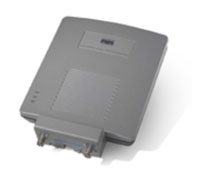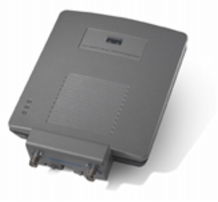+7 (812) 929-8283
Cisco Aironet 1230

Серия Cisco Aironet 1230AG обеспечивает высокую пропускную способность, безопасность и функциональные возможности устройств корпоративного класса, требуемые для работы в условиях сложной радиочастотной среды. Кроме того она снабжена двумя антенными разъемами для расширения зоны покрытия и предоставления более гибких возможностей по установке. Серия Cisco Aironet 1230AG объединяет в себе такие свойства, как высокая чувствительность приема и возможность увеличения времени ожидания сигнала, тем самым удовлетворяя самым жестким требованиям по надежности корпоративных сетей.
Общая архитектура построения беспроводных сетей Cisco Unified Wireless Network
Архитектура Cisco Unified Wireless Network обладает превосходными характеристиками в области безопасности, управляемости, функциональности и радио-частотной эффективности для предоставления беспроводного доступа к корпоративным приложениям.
Безопасность беспроводных сетей
Безопасность беспроводных сетей может быть обеспечена на очень высоком уровне. Узнайте больше о том, как это сделать стандартными средствами, а также о продуктах Cisco, позволяющих перейти на новый уровень контроля и защиты корпоративной беспроводной сети.
Cisco Aironet 1230AG Series 802.11A/B/G Access Point
Cisco® Aironet® 1230AG Series Access Points deliver the versatility, high capacity, security, and enterprise-class features demanded by WLAN customers. These IEEE 802.11a/b/g access points are designed specifically for challenging RF environments such as factories, warehouses, and large retail establishments that require the antenna versatility associated with connectorized antennas, a rugged metal enclosure, and a broad operating temperature range.

The Cisco Aironet 1230AG Series is a component of the Cisco Unified Wireless Network, a comprehensive solution that delivers an integrated, end-to-end wired and wireless network. Using the radio and network management features of the Cisco Unified Wireless Network for simplified deployment, the Cisco Aironet 1230AG Series extends the security, scalability, reliability, ease of deployment, and manageability available in wired networks to the wireless LAN.
The Cisco Aironet 1230AG Series is available in two versions: unified or autonomous. Unified access points operate with the Lightweight Access Point Protocol (LWAPP) and work in conjunction with Cisco wireless LAN controllers and the Cisco Wireless Control System (WCS). When configured with LWAPP, the Cisco Aironet 1230AG Series can automatically detect the best-available Cisco wireless LAN controller and download appropriate policies and configuration information with no manual intervention. Autonomous access points are based on Cisco IOS® Software and may optionally operate with the CiscoWorks Wireless LAN Solution Engine (WLSE). Autonomous access points, along with the CiscoWorks WLSE, deliver a core set of features and may be field-upgraded to take advantage of the full benefits of the Cisco Unified Wireless Network as requirements evolve.
AWARD-WINNING SECURITY
The Cisco Aironet 1230AG Series is listed on the National Institute of Standards and Technology (NIST) FIPS 140-2 Pre-Validation List and is in process for Information Assurance validation under the National Information Assurance Partnership (NIAP) Common Criteria program
The Cisco Aironet 1230AG Series supports 802.11i, Wi-Fi Protected Access (WPA), WPA2, and numerous Extensible Authentication Protocol (EAP) types. WPA and WPA2 are the Wi-Fi Alliance certifications for interoperable, standards-based WLAN security. These certifications support IEEE 802.1X for user-based authentication, Temporal Key Integrity Protocol (TKIP) for WPA encryption, and Advanced Encryption Standard (AES) for WPA2 encryption. These certifications help to ensure interoperability between Wi-Fi-certified WLAN devices from different manufacturers.
The Cisco Aironet 1230AG Series hardware-accelerated AES encryption supports enterprise-class, government-grade secure encryption over the WLAN without compromising performance. IEEE 802.1X authentication helps to ensure that only authorized users are allowed on the network. Backward compatibility and support for WPA client devices running TKIP, the RC4 encryption algorithm, is also supported by the Cisco Aironet 1230AG Series.
Cisco Aironet 1230AG Series Access Points operating with LWAPP support Cisco Unified Intrusion Detection System/Intrusion Prevention System (IDS/IPS), a software feature that is part of the Cisco Self-Defending Network and is the industry's first integrated wired and wireless security solution. Cisco Unified IDS/IPS takes a comprehensive approach to security-at the wireless edge, wired edge, WAN edge, and through the data center. When an associated client sends malicious traffic through the Cisco Unified Wireless Network, a Cisco wired IDS device detects the attack and sends shun requests to Cisco wireless LAN controllers, which will then disassociate the client device.
Autonomous or unified Cisco Aironet 1230AG Series Access Points support management frame protection for the authentication of 802.11 management frames by the wireless network infrastructure. This allows the network to detect spoofed frames from access points or malicious users impersonating infrastructure access points. If an access point detects a malicious attack, an incident will be generated by the access point and reports will be gathered on the Cisco wireless LAN controller, Cisco WCS, or CiscoWorks WLSE.
APPLICATIONS
Designed for rugged environments and installations that require antenna versatility, the Cisco Aironet 1230AG Series features antenna connectors for extended range or coverage versatility and more flexible installation options. Manufacturing applications, for example, can place WLANs in hazardous locations and remotely place antennas in the hazardous locations while securing the Cisco Aironet 1230AG Series access points within the wiring closet. The two remain connected via low-loss antenna cables.
The metal housing and industrial-grade components of the Cisco Aironet 1230AG Series provide the ruggedness and extended operating temperature range required in factories, warehouses, "big box" retail environments and similar facilities. High transmit power, receive sensitivity and delay spread for both 2.4 GHz and 5 GHz radios provide the long range and large coverage area consistent with these applications.
Access points may be placed above ceilings or suspended ceilings, allowing antennas to be discreetly placed below drop ceilings. The UL 2043 rating of the Cisco Aironet 1230AG Series allows the access points to be placed above ceilings in plenum areas regulated by municipal fire codes. Public access applications such as large hotel buildings may also present a challenging RF environment; the antenna versatility of the Cisco Aironet 1230AG Series, together with industry-leading range and coverage, provides reliable performance for the most demanding environments.
FEATURES AND BENEFITS
Table 1 lists the features and benefits of Cisco Aironet 1230AG Series access points.
Table 1. Features and Benefits of Cisco Aironet 1230AG Series Access Points
| Feature | Benefit |
|---|---|
| Dual 802.11a and 802.11g Radios | Provides up to 108 Mbps of capacity in a single device for industry-leading capacity and compatibility with older 802.11b clients. |
| Dual RP-TNC Antenna Connectors for Both 2.4-GHz and 5-GHz Radios | Antenna connectors support a variety of Cisco 2.4-GHz and 5-GHz antennas, providing range and coverage versatility. |
| Link-Role Flexibility | Autonomous access points can function as an access point or bridge, whether set up as a single-band or dual-band platform, allowing each radio to be individually configured as an access point repeater, root bridge, non-root bridge, or workgroup bridge, enabling a broad array of applications. |
| Cisco Unified IDS/IPS | This integrated software feature is part of the Cisco Self-Defending Network and is the industry's first integrated wired and wireless security solution. When a trusted client acts maliciously, the wired IDS detects the attack and sends shun requests to Cisco WLAN controllers, which will then disassociate the client device. |
| Management Frame Protection | This feature provides for the authentication of 802.11 management frames by the wireless network infrastructure. This allows the network to detect spoofed frames from access points or malicious users impersonating infrastructure access points. If an access point detects a malicious attack, an incident will be generated by the access points and reports will be gathered on the Cisco wireless LAN controller, Cisco WCS, or CiscoWorks WLSE. |
| Security | AuthenticationSecurity Standards |
| Currently Supports 12 Non-Overlapping Channels, with Potentially up to 23 Channels | Lower potential interference with neighboring access points simplifies deployment. Fewer transmission errors deliver greater throughput. |
| Rugged Metal Housing | Cast aluminum case and rugged features support deployment in factories, warehouses, the outdoors (in a NEMA enclosure), and other industrial environments. |
| UL 2043 Plenum Rating and Extended Operating Temperature | Supports installation in environmental air spaces such as areas above suspended ceilings. |
| Multipurpose and Lockable Mounting Bracket | Provides greater flexibility in installation options for site specific options, as well as theft deterrence. |
| Both Local and Inline Power Support | Power can be supplied using the Ethernet cable, eliminating the need for costly electrical power line runs to remotely installed access points. The access points can be powered by Cisco inline power switches, single port power injectors, or local power. |
| Hardware-Assisted AES Encryption | Provides high security without performance degradation. |
SUMMARY/CONCLUSION
Cisco Aironet 1230AG Series access points feature antenna connectors for greater range or coverage versatility using a broad selection of available Cisco antennas, as well as a rugged metal housing for operation over extended temperature ranges typical of industrial environments. Dual 802.11a and 802.11g radios deliver a combined capacity of 108 Mbps, meeting the performance requirements of the most demanding applications, while hardware-assisted AES encryption provides uncompromised support for interoperable IEEE 802.11i and WPA2 security.
PRODUCT SPECIFICATIONS
Table 2 lists the product specifications for Cisco Aironet 1230AG access points.
Table 2. Product Specifications for Cisco Aironet 1230AG Access Points
| Item | Specification | ||||
|---|---|---|---|---|---|
| Part Number | |||||
| Software | |||||
| Data Rates Supported | |||||
| Network Standard | |||||
| Uplink | |||||
| Radio Module Form Factor | |||||
| Frequency Band and Operating Channels | Americas (FCC) |
||||
| Non-Overlapping Channels | 802.11b/g: 3 channels | ||||
| Wireless Modulation | |||||
| Receive Sensitivity (Typical) | 802.11a |
802.11g |
|||
| Available Transmit Power Settings(Maximum Power Setting will Vary by Channel and According to Individual Country Regulations) | 802.11a:OFDM: |
802.11b:CCK: |
802.11g: |
||
| Range | Indoor: | Outdoor: | |||
| 802.11a: |
802.11g: |
802.11a: |
802.11g: |
||
| Ranges and actual throughput vary based upon numerous environmental factors so individual performance may differ. | |||||
| Antennas | 2.4 GHz |
||||
| LEDs | |||||
| Housing | |||||
| Dimensions (H x W x D) | |||||
| Weight | |||||
| Environmental | |||||
| Memory and Processor | |||||
| Input Power Requirements | |||||
| Power Draw | 13W maximum | ||||
| Warranty | One year | ||||
| Wi-Fi Certification |
|
||||

